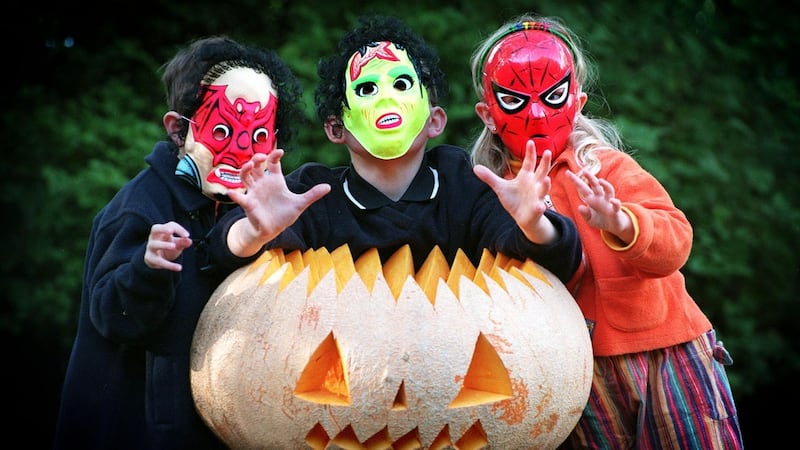Halloween holds echoes of a lost time. It’s about the only weekend of the year when the streets and parishes of Ireland are, once again, fully alive to the sounds of children playing outside and of laughter in the dark.
You’ll probably see them assembling around your neck of the woods just before dusk falls on Sunday: squadrons of youngsters armed with “candy buckets”, delighting in their elaborate disguises and costumes of the most terrifying figures in the culture – there’s Freddy Krueger,Ghostface... Is that James Corden?... Are you Mark Zuckerberg? The usual suspects.
Samhain has come full circle. Old Irish customs and superstitions transported to the United States on emigrant ships before being made slick and pop-culturally commercial in US suburbia have, over the past two decades, resurfaced here. Irish towns and villages play out with unabashed enthusiasm the scenes made familiar from the John Carpenter horror classics, which are all over Netflix at the moment: the lit pumpkins, the houses decorated in cobwebs and spooks, the headstones on the lawns, the shrieking ghosts.
As a social pageant, it’s a dress rehearsal for the full-blown insanity of Christmas. But for all of the commercial theatre of contemporary Halloween, it contains, for those few hours when kids move door to door and street to street in the dark, an authentic type of childhood magic. Because for many children, the sensation of being allowed to wander, of being out with their friends when it’s getting dark, is delicious and thrilling and new. And it’s a once-off.

It’s hard to identify precisely when the practice of children being out of doors in Ireland, all the time and in all weathers, ended.
But end it did.
When children play sport now, for instance, it is invariably organised, supervised sports to which they are generally driven to and collected from. The impromptu, chaotic sports of football games – on the street, on the green, in the back garden, on basketball or tennis courts, with the hastily chosen teams, the frequent bust-ups and conciliations, the playing on when its getting too dark to properly see the ball and the life-or-death importance of it all – or stupid chasing games that could last for hours, partly because there was nothing else to do – that stuff has all but disappeared.
The vast majority of kids don’t “play” in that way anymore. Speak to anyone involved in coaching kids in sport now and they will bemoan the fact that outside of the structured, scheduled hours of sport, the kids on the team, even those with exceptional aptitude, do not play with a ball socially.
Most theories as to why this happens involve the multitude of screens and other entertainment available. And speak to any parent and they will readily concede that they wouldn’t dream of giving their nine- or 10- or 12-year-old the same freedom to wander and just be “out” that they cherished at the same age.
Walk or cycle
Do children walk places anymore? Two-car households have become commonplace rather than a rarity over the past few decades. Before then, children walked or cycled to and from training or to friends’ houses because often, there was no other choice. This is not to say that there are not, right now, casual games of football taking place on a patch of grass in towns or cities across Ireland. But it happens in nowhere near the same numbers as was the case a generation ago. There has been a mass migration indoors.
If you want to truly frighten an Irish child today, all you have to do is tell them about the rituals of the Irish Halloween in the 1980s. Costumes were virtually unheard of, save those pointed black witches hats, which generally disintegrated in the rain. It was all about the upholding of old customs then.
No, it was fun, you’d insist, ’cos you’d fill a basin up with water and throw things to the bottom and take turns ducking your head to the bottom to try and fish the prize out with your mouth!
And, yeah, maybe it felt a bit lonely and scary down there, with your face immersed in the icy water and your eyes squeezed shut as you scrabbled about in utter darkness, trying not to swallow gallons of water or submit to the shame of surfacing empty-mouthed, so that sometimes you’d choke and splutter and, between wheezing breaths and the taunting laughter of friends and siblings, explain that the water “went down the wrong way ”.
Or you’d explain how people used to tie an apple on a string from the ceiling so everyone could take turns standing on a chair with your hands behind your back and try and take a bite.
Incomprehension
Witness, then, the look of glazed incomprehension and fleeting sympathy and, finally, a kind of disappointment – in you, for you – that moves across the face of your darling as he or she imagines all of this before asking the only logical question: why did you do that? It’s a look that contains sympathy, harsh judgment and, finally, sharp relief that they were not born into the grim Halloween scene of the faraway 1980s.
Of course, the 1980s in Ireland was such a nonstop gothic trip that it would have been impossible and nonsensical to create a single weekend’s celebration of the frightening and the spooky. It was like that all the time. For better or worse, Irish children now move through their childhoods in much more structured and supervised patterns. Maybe it makes for a safer environment and “better” parenting. That’s for the experts to decide.
But what has been lost is the unbeatable freedom of “being out” – the uncertainty and fear and independence that comes with being out with your friends when it’s dark. Listen closely on Halloween night and you’ll hear – for one night only – the joy in all of that.













